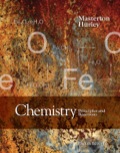
(a)
Interpretation:
The number of protons and electrons in aS8 molecule needs to be deduced
Concept Introduction:
- Every system found in nature is a composite of atoms, molecules, ions or other particles
- These are composed of fundamental subatomic particles: protons, neutrons and electrons.
- Each atom is characterized by two quantities:
Atomic number (Z) andatomic mass (A)
Z = atomic number = number of protons = number of electrons ------ (1)
A = atomic mass = number of protons + number of neutrons ------ (2)
For an ion: number of electrons = number of protons + charge on the ion ------ (3)
(b)
Interpretation:
The number of protons and electrons in
Concept Introduction:
- Every system found in nature is a composite of atoms, molecules, ions or other particles
- These are composed of fundamental subatomic particles: protons, neutrons and electrons.
- Each atom is characterized by two quantities: Atomic number (Z) and atomic mass (A)
Z = atomic number = number of protons = number of electrons ------ (1)
A = atomic mass = number of protons + number of neutrons ------ (2)
For an anion: number of electrons = number of protons + charge on the ion ------ (3)
For a cation: number of electrons = number of protons - charge on the ion ------ (4)
(c)
Interpretation:
The number of protons and electrons in H2S molecule needs to be deduced
Concept Introduction:
- Every system found in nature is a composite of atoms, molecules, ions or other particles
- These are composed of fundamental subatomic particles: protons, neutrons and electrons.
- Each atom is characterized by two quantities: Atomic number (Z) and atomic mass (A)
Z = atomic number = number of protons = number of electrons ------ (1)
A = atomic mass = number of protons + number of neutrons ------ (2)
For an anion: number of electrons = number of protons + charge on the ion ------ (3)
For a cation: number of electrons = number of protons - charge on the ion ------ (4)
(d)
Interpretation:
The number of protons and electrons in
Concept Introduction:
- Every system found in nature is a composite of atoms, molecules, ions or other particles
- These are composed of fundamental subatomic particles: protons, neutrons and electrons.
- Each atom is characterized by two quantities: Atomic number (Z) and atomic mass (A)
Z = atomic number = number of protons = number of electrons ------ (1)
A = atomic mass = number of protons + number of neutrons ------ (2)
For an anion: number of electrons = number of protons + charge on the ion ------ (3)
For a cation: number of electrons = number of protons - charge on the ion ------ (4)
Trending nowThis is a popular solution!

Chapter 2 Solutions
EBK CHEMISTRY: PRINCIPLES AND REACTIONS
- Provide the missing information. *see imagearrow_forwardDraw the mechanism (including all curved arrows for electron movement) showing how the maleicanhydride is attacked by the anthracene and formation of the final Diels Alder product.arrow_forwardProvide the missing information. *see imagearrow_forward
- Provide the missing information. *see imagearrow_forwardProvide the missing information. *see imagearrow_forwardI have a bottle of butanal that has been improperly used by lab workers. They allowed a traceamount NaOH (aq) to contaminate the bottle. What is now in my bottle of “butanal? What is the molecular name and functional group name? Draw the structure.arrow_forward
- Provide the missing information. *see imagearrow_forwardFirst image: Why can't the molecule C be formed in those conditions Second image: Synthesis for lactone C its not an examarrow_forwardFirst image: I have to show the mecanism for the reaction on the left, where the alcohol A is added fast in one portion Second image: I have to show the mecanism of the reaction at the bottom. Also I have to show by mecanism why the reaction wouldn't work if the alcohol was primaryarrow_forward
 Chemistry: Principles and PracticeChemistryISBN:9780534420123Author:Daniel L. Reger, Scott R. Goode, David W. Ball, Edward MercerPublisher:Cengage Learning
Chemistry: Principles and PracticeChemistryISBN:9780534420123Author:Daniel L. Reger, Scott R. Goode, David W. Ball, Edward MercerPublisher:Cengage Learning ChemistryChemistryISBN:9781305957404Author:Steven S. Zumdahl, Susan A. Zumdahl, Donald J. DeCostePublisher:Cengage Learning
ChemistryChemistryISBN:9781305957404Author:Steven S. Zumdahl, Susan A. Zumdahl, Donald J. DeCostePublisher:Cengage Learning Chemistry: An Atoms First ApproachChemistryISBN:9781305079243Author:Steven S. Zumdahl, Susan A. ZumdahlPublisher:Cengage Learning
Chemistry: An Atoms First ApproachChemistryISBN:9781305079243Author:Steven S. Zumdahl, Susan A. ZumdahlPublisher:Cengage Learning
 Organic ChemistryChemistryISBN:9781305580350Author:William H. Brown, Brent L. Iverson, Eric Anslyn, Christopher S. FootePublisher:Cengage Learning
Organic ChemistryChemistryISBN:9781305580350Author:William H. Brown, Brent L. Iverson, Eric Anslyn, Christopher S. FootePublisher:Cengage Learning




